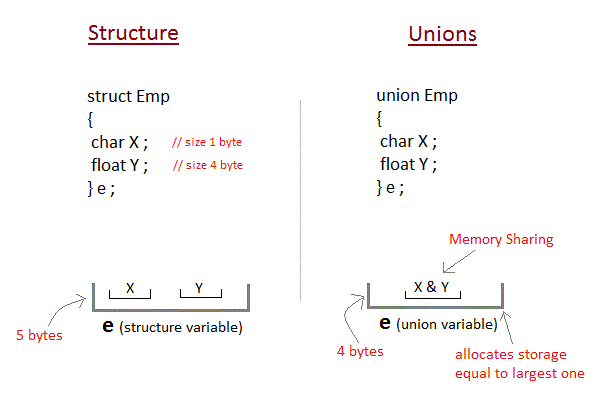Unions in C

Unions
A union is a derived type (similar to a structure) with members that share the same storage space (sometimes the same type of construct needs different types of data). They are used mainly in advanced programming applications where it is necessary to store different types of data in the same storage area, they can be used to save space and for alternating data. A union does not waste storage on variables that are not being used.
Each element in a union is called "member". You can define a union with several members, but only one member can contain a value at any given time, so you can only access one member at a given time.
The members of a union can be of any datatype, in most cases, unions contain two or more datatypes and it is also your responsibility to ensure that the data in a union is referenced with the proper datatype - referencing data in a union with a variable of the wrong type is a logic error - it can cause your program to crash.
The operations that can be performed on a union are:
-
Assigning a union to another union of the same type.
-
Taking the address (&) of a union variable.
-
Accessing union members.
Examples
Unions are particularly useful in embedded programming situations where direct access to the hardware/memory is needed - because you are saving memory -. You could use a union to represent a table that stores a mixture of types in some order, you could create an array of unions that store equal-sized units, each of which can hold a variety of datatypes, a union could represent a file containing different record types, a network interface containing different request types, and so much more.
Memory Allocation for a Union
Although structs are similar to unions, the memory allocated for a union is quite different than for a struct. Every time you create an instance of a struct, the computer will lay out the fields in memory, one after the other, it allocates space for all its members separately. With a union, all the members have an offset of zero - there's one common storage space for all its members. A union is created with enough space for its largest field, the programmer then decides which value will be stored there. If you a union called quantity - for example -, with fields called count, weight and volume, whether you set the count, weight or volume field, the data will go into the same space in memory.

Source: studytonight.com
Example
Let's suppose you want to keep track of a quantity of something, it might be a count, a weight or a volume. You could create a structure like this:
struct fruit {
short count;
float weight;
float volume;
};There are a few reasons why this is not a good idea:
-
It will take up more space in memory.
-
Someone might set more than one value.
-
There's nothing called quantity.
A union should be used in this situations. You could specify something called quantity in a datatype, you can decide for each particular piece of data whether you are going to record a count, a weight or a volume against it.
Structs vs unions
Even though unions are similar to structures, they are used for entirely different situations:
-
You should use a structure when your construct should be a group of other things.
-
You should use a union when your construct can be one of many different things but only one at a time.
-
Unions are typically used in situations where space is premium, but more importantly, for exclusively alternate data.
-
Unions ensure that mutually exclusive states remain mutually exclusive.
-
Unions share a common storage space where structures store several datatypes simultaneously, for example, a structure can hold an int, and a dobule and a char, whereas a union can hold an int, or a double, or a char.
Defining a Union
The definition for a union, is identical to that of a structure, except the keyword union is used where the keyword struct is otherwise specified. A union has the general form:
union [union_tag] {
type_1 identifier_1;
type_2 identifier_2;
...
type_N identifier_N;
} optional_variable_definitions;The union tag is optional and each member definition is what we are used to do. Note that, as well as structures, you can specify one or more union variables before the semicolon but it's optional. The union definition is usually placed in a header and included in all source files that use the union type.
Example
Let's look at an example:
union _data {
int i;
float f;
char str[20];
} data;The above does not declare `data' to contain three distinct members called `i', `f' and `str', it defines `data' to contain a single member that is either `i', `f' or `str'.
A variable of type `_data' can store an integer, a floating-point number of a string of characters, a single variable (same memory location) can be used to store multiple types of data.
The memory occupied by a union will be large enough to hold the largest member of the union, any variable of type `_data' will occupy 20 bytes of memory, because this is the maximum space which can be occupied by a character string.
Creating union variables
When a union is defined, it creates a user-defined type, it doesn't allocate memory for it. To allocate memory for a given union type and work with it, we need to create variables.
A union can be defined to contain as many members as you want, and they can be the members of a structure (they can even be arrays). Pointers to unions can also be declared, their syntax and rules for performing operations are the same as for structures.
Example
#include <stdio.h>
union car {
int i_value;
float f_value;
char c_value[40];
};
int
main (void)
{
union car c1, c2, *c3;
printf ("sizeof (c1): %zu\n", sizeof (c1));
return 0;
}